VILLAGE LIFE
And behold it was a village in the countryside, not many hours from the big city; there among the trees, the narrow streets and the old farm houses a festival was going on in which, among the villagers attending – the elders and the drunks, the kids, the mothers and the fathers – young macho handsome guys put on old tapestries like skirts, danced in the streets and didn't even begin to laugh at one another, wore long red hair and masks and gestured crazily in the complete confidence that deep tradition affords, for tradition is a great strength, the bond of a society.
And so it was good, it was food, to go to that far village fest and behold the young performing these rituals as they had been told, and as these village young have always done, for all the young lives till now and without complaint, for this is the tradition of their place, this is what they have been and are living, the tradition of their forebears far back. So it was that the young went through what for the young is hell: a pained and protracted learning of ancient rituals that have no place in this real world, that take time and slow it down then bend it backwards, when all the thrust of the modern world is forward at top speed into a future made in offices.
To their immediately personal eyes and minds, this ceremony was the stuff of old folks but they did it anyway, faithfully; and so, as you could see in their faces, as the rite took place they began to sense the value of this social bond, that through them, and all the eyes on them, holds all this together against the fast-approaching, sky-sized metablob of uniforming change that is oozing toward them and their village on all fronts; it was food to see and know that what is left in the local heart can still hold together in the face of that onslaught, that the young can still be turned to the good of all in a village where not all youth is leaving for the facelessness of the big city world and its apartness, when here the folk and their place are so together-rooted as to germinate hope for the ancient reach of us each in the world, that hearts may bear this hard-won wisdom beyond this new age to where newer lives will take it up, make it their own and hand it down, so that what is good about growth will go on.
Previously published, in slightly different form, in Kyoto Journal #57.
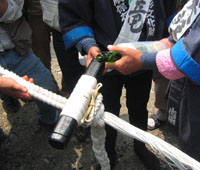 You know how it is when you build a kite that's bigger than your house and weighs about a ton: on the big day you're set to fly it, it rains, right? It's always the way. So you postpone the big day till next week. And because in the case of which I speak your giant kite is made of bamboo and rice paper, watercolored in painstaking detail with symbols of flight and wind and power, you can't just leave it out in the rain, you've got to store it somewhere - somewhere big - but nothing's so big in Japan that's also empty, so you throw a couple dozen tarps over your kite and wait till next week.
You know how it is when you build a kite that's bigger than your house and weighs about a ton: on the big day you're set to fly it, it rains, right? It's always the way. So you postpone the big day till next week. And because in the case of which I speak your giant kite is made of bamboo and rice paper, watercolored in painstaking detail with symbols of flight and wind and power, you can't just leave it out in the rain, you've got to store it somewhere - somewhere big - but nothing's so big in Japan that's also empty, so you throw a couple dozen tarps over your kite and wait till next week.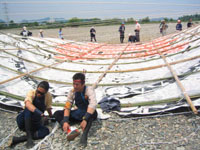 And as is also always the way, next week's big day dawns blue and bright, with puffy clouds just hanging there, like popcorn on a string, in the kitist's anathema: still air. That is, air in which the motion of one's own breath is impressive. So when we arrived late in Yokkaichi for the big festival (postponed last week by rain), it didn't matter: at kite takeoff time there was barely enough wind to lift a tiny paper tissue kite above eye level if several folks blew upward.
And as is also always the way, next week's big day dawns blue and bright, with puffy clouds just hanging there, like popcorn on a string, in the kitist's anathema: still air. That is, air in which the motion of one's own breath is impressive. So when we arrived late in Yokkaichi for the big festival (postponed last week by rain), it didn't matter: at kite takeoff time there was barely enough wind to lift a tiny paper tissue kite above eye level if several folks blew upward.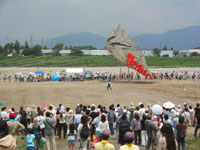 In quest of a breeze it took a few hours of massively collective waiting and mob-shifting the huge kite from one direction to another and back again in the dry part of the wide riverbed, but at last in the afternoon the big kite took off, to the sound of an immense sigh from the crowd that seemed to lift the kite a bit higher. I've never seen so many kites or kite fanatics in one place before. It's a great thing to know that so many love what I used to misguidedly think of as a kid's toy. It was a pleasure to stand corrected among them and watch them at their art.
In quest of a breeze it took a few hours of massively collective waiting and mob-shifting the huge kite from one direction to another and back again in the dry part of the wide riverbed, but at last in the afternoon the big kite took off, to the sound of an immense sigh from the crowd that seemed to lift the kite a bit higher. I've never seen so many kites or kite fanatics in one place before. It's a great thing to know that so many love what I used to misguidedly think of as a kid's toy. It was a pleasure to stand corrected among them and watch them at their art.
 It was no mystery that Basho, at the end of a life spent wandering in pursuit of plain and humble beauty, chose as his resting place this small, quiet temple that perfectly manifests the principle of
It was no mystery that Basho, at the end of a life spent wandering in pursuit of plain and humble beauty, chose as his resting place this small, quiet temple that perfectly manifests the principle of  So there they lie, side by side: the tragic, vainglorious, multiply betrayed warrior and the simple, reclusive wandering poet, in precincts dotted with many haiku-carved stones - placed there by Basho's students and admirers over the centuries - and the grave stone of Kiso's Kyoto mistress over there in the corner (she killed herself upon hearing Kiso had been slain; Kiso's wife was forced to marry into the victorious side of the Minamoto clan, later became a mendicant nun and returned to Nagano in her final days...
So there they lie, side by side: the tragic, vainglorious, multiply betrayed warrior and the simple, reclusive wandering poet, in precincts dotted with many haiku-carved stones - placed there by Basho's students and admirers over the centuries - and the grave stone of Kiso's Kyoto mistress over there in the corner (she killed herself upon hearing Kiso had been slain; Kiso's wife was forced to marry into the victorious side of the Minamoto clan, later became a mendicant nun and returned to Nagano in her final days...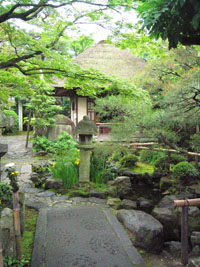 After our visit to Ishiyamadera we went looking for Basho's grave, which I'd been surprised to learn was in Otsu (where Basho spent lot of time) and had since wanted to visit. In our fully intact expedition naivete we didn't need a map, of course; who would need a map to find the small-town grave of Japan's most famous poet and the whole world's haiku master?
After our visit to Ishiyamadera we went looking for Basho's grave, which I'd been surprised to learn was in Otsu (where Basho spent lot of time) and had since wanted to visit. In our fully intact expedition naivete we didn't need a map, of course; who would need a map to find the small-town grave of Japan's most famous poet and the whole world's haiku master?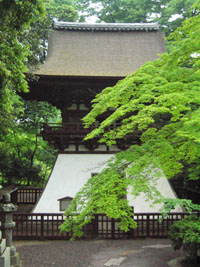 Went in the rain to Ishiyamadera and realized anew, in all that wet and verdant beauty arranged along the mountainside, the deep truth of
Went in the rain to Ishiyamadera and realized anew, in all that wet and verdant beauty arranged along the mountainside, the deep truth of 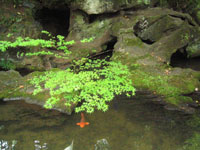
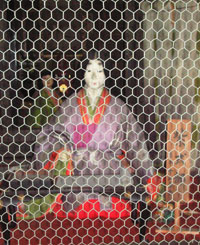 in one of which Basho himself stayed awhile,
in one of which Basho himself stayed awhile,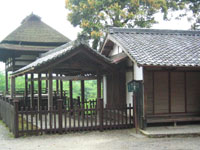 no doubt enjoying what must have been a fantastic Seto-river-and-moon-viewing and haiku-writing platform back in the Basho days.
no doubt enjoying what must have been a fantastic Seto-river-and-moon-viewing and haiku-writing platform back in the Basho days.
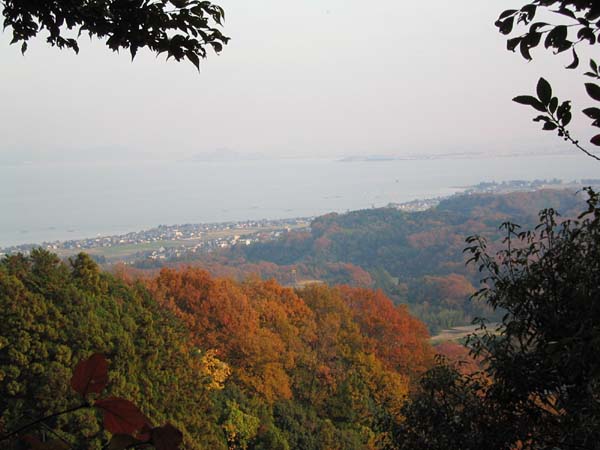
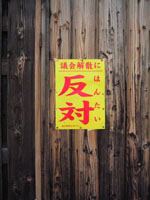 Despite the fact that
Despite the fact that 
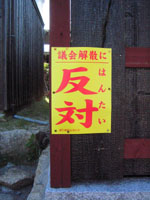 You'd think something would have been learned by now, but general licensed depredation of all that is natural and genuine - for the particular advantage of a select few - seems to be the way of history, at least in the short term, though no short term has ever been as potentially deadly as the one we're now living through.
You'd think something would have been learned by now, but general licensed depredation of all that is natural and genuine - for the particular advantage of a select few - seems to be the way of history, at least in the short term, though no short term has ever been as potentially deadly as the one we're now living through.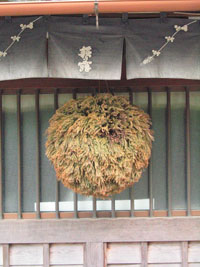 Two months ago at about this time I went to Takashima up the road along the Lake and visited '
Two months ago at about this time I went to Takashima up the road along the Lake and visited '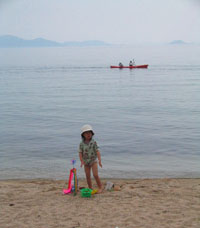 On Sunday's beautiful morning we went north to our favorite kiddy beach just south of Matsu-no-ura, where there's a long narrow shaded lawn with gazebo and table right beside the sandy stretch of beach that segues into Matsu-no-ura proper (just go north along the beach shore road that starts at Horai and take a right at the police box, then a left; park close by the stone wall). You gotta get there early though in beach season, which we can do since we live only 5 minutes away.
On Sunday's beautiful morning we went north to our favorite kiddy beach just south of Matsu-no-ura, where there's a long narrow shaded lawn with gazebo and table right beside the sandy stretch of beach that segues into Matsu-no-ura proper (just go north along the beach shore road that starts at Horai and take a right at the police box, then a left; park close by the stone wall). You gotta get there early though in beach season, which we can do since we live only 5 minutes away.
















